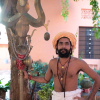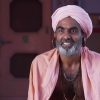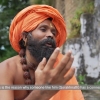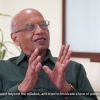Introduction
Although a popular translation for the word ‘yoga’ is ‘union’, recent scholarship shows that throughout history the meanings of yoga have been multiple and subtly shifting: from the yoga-kṣema of the Vedic pastoralists (which indicated habitation cycles of movement and rest) to the classical meaning of Pātañjala yoga as ‘meditative concentration’ to medieval tantric techniques to bring about metaphysical union in the yogic body. The understandings and practices of yoga have changed over the ages. We can trace a thread of continuity back to the Vedas, where ideas about yoga were nascent, and particularly to the Upaniṣads in which we begin to see its proto-systems. In c. 4th century BCE, the Sanskrit grammarian Pāṇini noted two verbal forms for the root ‘yuj’: ‘yuji’ denotes joining or uniting (cognate with the English ‘yoking’) and ‘yuja’ denotes ‘concentration’ in the sense of samādhi. The Upaniṣads emphasised both these meanings in their formulation of meditation to produce liberating knowledge. Another important contribution to the development of yoga as systematic thought came from the ascetic śramaṇa (striver) communities, from which the religions of Buddhism and Jainism also emerged.
Indus Valley Civilisation and the Yoga Seals
The origins of yoga are sometimes traced back to Harappan culture, also called the Indus Valley Civilisation. However, contextual evidence for such a claim is limited. Harappa was a highly developed urban culture in the Indian subcontinent, dated 4th to 2nd millennia BCE. During excavations of this Bronze Age civilisation, there were archaeological finds in the Indus Valley. Some scholars claimed that a series of carved stone seals—engraved with iconographic motifs and the Indus script—contain images of early yoga practice. The most famous of the seals was from Mohenjodaro, named the ‘Proto-Śiva seal’ by a British archaeologist, John Marshall, who discovered it in the early 20th century. This seal shows an anthropomorphic figure in a cross-legged posture, wearing a headdress and surrounded by animals. However, interpretations of the seal are contested, and, given that the Indus script remains undeciphered by scholars, further research remains to be done.
Vedic Civilisation
The decline of the Indus civilisation in India was followed by the emergence of Vedic civilisation in the 2nd millennium BCE. A migration of peoples from the Central Asian steppes brought with them a proto-Indo-European language from which Sanskrit developed. They also brought the complex beliefs, practices and oral texts that comprised Vedic culture. Veda means ‘knowledge’ and refers to traditions that were preserved in oral texts—the Vedas. There are four Vedas, composed between the 2nd and 1st millennia BCE:
- Ṛg Veda
- Sāma Veda
- Yajur Veda
- Atharva Veda
They are referred to as śruti, meaning ‘heard’—these texts are believed to have been divinely revealed to sages who were known as ṛṣis. The poetic speech and vision of the ṛṣis was called dhī and this word and concept would become foundational to the later contemplative practices of dhyāna (meditative absorption), derived from the same term.
Another important concept in the Vedas is tapas. Tapas is derived from the verbal root ‘tap’, meaning ‘to give out heat’ or ‘to be hot’. In Vedic usage, it referred to both the cosmic heat of creation and to bodily heat (and power) generated by forms of asceticism. Tapas was also linked with prāṇāyāma (breath control), fasting, and other ascetic practices. There are several examples of figures in the Vedas who were associated with asceticism:
Vrātya: The vrātyas were roaming warriors, or Vedic students, who undertook a vow (vrata) and performed rituals focused on fertility.
Keśin: The ascetic keśin (‘the long-haired one’) may have been one and the same as the muni (‘the silent one’). The keśin is described in Ṛg Veda 10.136 as the long-haired one who bears fire and can mount the wind.
Brahmacārin: The brahmacārin was the celibate Vedic student. He was also associated with fire because it was the brahmacārin’s role to light and maintain the sacred fire of his teacher’s home.
Yoga in the Upaniṣads
The Upaniṣads are also known as Vedānta, the end of the Vedas, meaning that they were the last part of the Vedic canon to be composed. The principal Upaniṣads number 12–15 (this categorisation is debated) and range in date from approximately 800 BCE up to the early centuries of the Common Era.
The Upaniṣads introduced innovative ideas about the self and rebirth. They are particularly important to the history of yoga because it is in these texts that we see the first detailed descriptions and proto-systems of yoga. They are also the texts in which we encounter the concepts of ātman and brahman. Ātman, or self, is one’s true identity that is hidden from ordinary perception. Knowledge of this self is the goal of contemplative enquiry. Indeed, the knowledge of self is that ātman is identical to brahman (the cosmic principle). Another important idea in the Upaniṣads was the emphasis on new ideas around karma and rebirth. According to this theory, one was responsible for the accrual of merit or demerit in life, according to good or bad acts, or karman. Reincarnation in another body was determined by one’s karma in a previous life. Scholars such as Bronkhorst[i] argue that the theory of karma evolved, not in Vedic culture, but in the śramaṇa (striver) communities.
The Upaniṣads explain the link between controlling the breath (prāṇa) and controlling the mind (manas) (Chāndogya Upaniṣad 6.8.2)[ii] and list five types of prāṇa—prāṇa, apāna, vyāna, udāna, and samāna (Bṛhadāraṇyaka Upaniṣad 3.9.26)[iii]. They also describe a system of energy channels called nāḍīs that run up to the crown of the head.
One hundred and one, the veins (nāḍī) of the heart.
One of them runs up to the crown of the head.
Going up by it, he reaches the immortal.
The rest, in their ascent, spread out in all directions.
(Chāndogya Upaniṣad 8.6.6)[iv]
In Kaṭha Upaniṣad (3.3–4; 6.10–6.11)[v], the self is compared to a rider in a chariot and the act of yoga is that of controlling the mind and senses as a charioteer controls the reins. This stilling of ordinary perception then facilitates the observation that the inner controller is brahman.
When senses are firmly reined in,
that is Yoga, so people think.
From distractions a man is then free,
for Yoga is the coming-into-being,
as well as the ceasing-to-be (Kaṭha Upaniṣad 6.10–6.11)
Śvetāśvatara Upaniṣad (2.8–10)[vi] provides information on how to practice contemplation: with the body straight, practicing breath control, in a clean and quiet environment.
Praśna Upaniṣad (5.5)[vii] describes contemplation as recitation of the syllable oṃ, understood as a sonic embodiment of brahman. In Maitrī (or Maitrāyaṇa) Upaniṣad (6.18)[viii], we find one of the first systems of yoga, comprising six auxiliaries or aṅga:
- prāṇāyāma
- pratyāhāra (sensory withdrawal)
- dhyāna (mental absorption)
- dhāraṇā (mental fixing)
- tarka (discrimination/reasoning)
- samādhi (concentration)
The goal of this system was knowledge of brahman.
Śramaṇa Religions
Another important context for the emergence of yoga in the 1st millennium BCE was that of the śramaṇa communities, the renouncer traditions of Northeast India from which the religions of Buddhism and Jainism emerged. Śramaṇa means ‘striver’ or ‘one who performs acts of austerity’ (from the verb root ‘śram’, ‘to strive’). It was in the śramaṇa milieu that innovative concepts of karma and rebirth were forged.[ix] The śramaṇa communities grew up around charismatic leaders such as Maskarin Gosāla who founded the Ājīvikas; Vardamāna Mahāvīra who founded Jainism; and Gautama Buddha, the founder of Buddhism. The Jains had strong ascetic practices to destroy past karmas. They adhered to five vows called the mahāvratas, the same as the five yamas (observances) in later Pātañjala yoga. The Buddhists focused on desire as the existential problem to be overcome and they proposed different meditative paths to eliminate karma. The extent of dialogue between Brahmin, Jain, and Buddhist thinkers is often reflected in popular narratives, which contain many shared stories and figures. Looking back historically, it can be difficult to separate strands of communal thinking and to identify exactly which aspects of yogic practice were developed in the Vedic context and which in the context of the śramaṇa religions. Most likely, the systematised yoga of the classical era was a product of dialogue between these different groups.
Yoga in the Epic Tradition
Yoga appears as a key theme in the Indian epic the Mahābhārata, composed around the beginning of the Common Era. The most detailed discussions of yoga take place in two sections: the Bhagavad Gītā and the Śānti Parvan.
Bhagavad Gītā
The Bhagavad Gītā recounts a dialogue between the Pāṇḍava prince Arjuna and his charioteer Kṛṣṇa, who turns out to be none other than the supreme godhead Viṣṇu. The story centres on Arjuna’s dilemma in entering into battle against his extended family. Kṛṣṇa offers advice and explains the virtues of different types of yoga.
Karma yoga: Karma refers to ‘action’ and has the goal of being able to act in the world without having attachment to the fruits of one’s action. Ultimately, one should offer the fruits of actions to Kṛṣṇa. Actions that are offered devotionally are not subject to the usual laws of cause and effect.
Jñāṇa yoga: The yoga of knowledge (jñāna) is linked to sacrifice in that defilements and desire are offered up in the fire (agni) of knowledge. Jñāna yoga is also identified with the philosophy of Sāṃkhya.[x]
Bhakti yoga: Bhakti (devotion) is a loving attitude towards the supreme godhead characterised by surrender, loyalty, worship and dependence. In return, one receives affection and protection.
In the way that Kṛṣṇa is shown to have mastery or control over nature itself (prakṛti), the yogin has to have mastery over one’s own nature (svaprakṛti). Ultimately, the Bhagavad Gītā[xi] emphasises bhakti yoga in which Arjuna’s dilemma is resolved by loyalty to Kṛṣṇa (Bhagavad Gītā 3.30).
Sānti Parvan is chapter 12 of the Mahābhārata. Set in the aftermath of war, it partly describes how the new king, Yudiṣṭhira, receives teachings on yoga as the means to spiritual liberation. Meditation practices include sense control, dhāranā, dhyāna and samādhi. Through these efforts, yogins attain manaḥśānti (peace of mind). Other practices include japa (quiet recitation), prāṇāyāma and dietary restrictions. The goal of practice is mokṣa.
Yoga in the Classical Period
In classical Indian philosophy, yoga is paired with a school of thought called Sāmkhya—which means ‘enumeration’ or ‘distinction’—from the verbal root saṃ√khyā, ‘to count’ or ‘to name’. The enumeration refers to a list of tattvas (principles of reality) and to the examination of these factors. The first preserved text of Sāṃkhya is Sāmkhyakārikā by Īśvarakṛṣṇa (4th century CE), which describes reality as two separate but co-fundamental principles:
- puruṣa, the principle of pure consciousness
- prakṛti, the principle of pure materiality which includes sense capacities and the mind
All in all, there are 24 tattvas that belong to prakṛti while the 25th tattva is puruṣa, which stands apart. When prakṛti is in an unmanifested state, its three primary qualities are in perfect equilibrium. These three qualities are the guṇas:
- sattva (balance, purity)
- rajas (kinesis, movement)
- tamas (inertia, reification of matter, darkness).
When prakṛti changes state and begins to emanate, the tattvas (principles) evolve to create diverse material reality. Sāṃkhya also puts forward a theory of mind as a three-fold complex comprised of buddhi (intelligence, discernment), ahaṃkāra (sense of I or the ego), and manas (mundane mind, thinking). In Sāṃkhya, one attains liberation by correctly perceiving the categories (prakṛti and puruṣa) and by realising the true identity as puruṣa. The aim is to isolate (kaivalya) pure consciousness (puruṣa) from the activities of the mind and the external world.
Yoga Sūtra
The Yoga Sūtra of Patañjali comprises of 195 aphorisms or sūtras and divided into four chapters or pādas. It is variously dated from around the 2nd to the 4th century CE - for example, Philipp Maas currently dates the text to around 400 CE. Certainly parts of it may date to several centuries earlier. Retaining its status and popularity over the centuries, the Yoga Sūtra underwent a change in status in the modern period. Adopted by early international teachers of yoga from the late 19th century onwards, the Yoga Sūtra has been one of the core texts at the centre of the global growth of yoga. It continues to be translated into languages worldwide up until the present day. In Western academic research, Philipp Maas[xii] has argued that the Yoga Sūtra should be regarded as one conjoined text with its commentary the Yogasūtrabhāṣya—both authored/compiled by Patañjali and given the encompassing title Pātañjalayogaśāśtra.
Yoga Sūtra (1.2) contains the maxim yogaś cittavṛttinirodhaḥ, ‘yoga is the cessation of the fluctuations of the mind’, and offers practice (abhyāsa) and dispassion (vairāgya) as the two means to achieve this cessation. It describes kriyā yoga (the yoga of action), a method containing three techniques. (2.1) These techniques are austerity (tapas), Vedic recitation (svādhyāya) and devotion to īśvara (a higher principle or being that is ambivalently theistic). This method is designed to reduce or eliminate negative states of mind called the kleśas (afflictions) and to attain samādhi. It also describes aṣṭāṅga yoga or the yoga of eight auxiliaries:
- yama (restraints)
- niyama (observances)
- āsana (seat/posture)
- prāṇāyāma
- pratyāhāra
- dhāraṇā
- dhyāna
- samādhi
Vedānta
In the 8th century CE, the philosopher Śaṅkara wrote a number of commentaries on texts such as the Brahma Sūtra, the Bhagavad Gītā, and the Yoga Sūtra.[xiii] Śaṅkara is credited as the founder of a philosophical approach called Vedānta, meaning that it is focused on the Upaniṣads. Śaṅkara emphasised a non-dual relationship between ātman and brahman and their identical nature. His proposed method to liberation was knowledge alone. He also argued that there is nothing real or unreal, apart from brahman. However, according to Śaṅkara, reality was commonly misperceived: in error we superimpose the changing world onto brahman and thus mistake an unreal object for a real one. This point was illustrated by the famous analogy of mistaking a rope for a snake. Vedānta played an important role in the history of yoga because many medieval commentaries on the Yoga Sūtra were written by scholars of Vedānta. Therefore, the way in which the key concepts of classical yoga were interpreted by Indian scholars was often informed by Vedāntin ideas. For example, Vedānta prioritises the relationship of brahman-ātman over that of prakṛti-puruṣa, thereby replacing Patañjali’s dualist ontology with a non-dual one. (Some studies have argued that early Sāṃkhya was itself non-dualist but we have little extant evidence, and there is no reflection of such a position in the Yoga Sūtra).
Tantra
Hindu tantric traditions are theistic and focus on forms of Śiva, Śakti or (to a lesser extent) Viṣṇu. Tantric practices are designed to lead one to liberation, commonly a non-dual merging or unity with the godhead. Indeed, the goal is often to attain divine consciousness. The earliest of the Śaiva sects is considered to be the Pāśupata ascetics. They took their name from Śiva’s epithet as Paśupati (lord of the animals) and were wandering ascetics who carried tridents or clubs and smeared their bodies with ash. The Pāśupatas practiced yoga, which was meditation, and performed lifelong asceticism in order to attain the goal of union with Śiva (Śiva yoga).
By the mid-1st millennium CE the Purāṇas, a corpus of populist texts that extol and elaborate the stories of the Vedas in colourful detail, were in circulation. These texts included accounts of worship of the goddess: both awesome forms such as Caṇḍī or Caṇḍīka and auspicious forms such as Śiva’s wife, Pārvatī. Pārvatī is revered as a great yoginī who practices austerities (tapas) on the mountain Śrīpārvata. The early Purāṇas mark the beginnings of tantric traditions that conceive of the goddess as the supreme power, Śakti.
Medieval tantric practices were frequently antinomian (rejecting social norms) and were opposed to orthodox or smārta practices that rested on normative concepts such as dharma. In order to demonstrate that there is nothing that is not divine, tantra often dissolves or reverses values in the polarities of purity/pollution, dharma/adharma, merit/demerit, and saṃsāra/mokṣa. In fact, polarities are especially productive in tantra; the ultimate polarity of Śiva and Śakti (the divine masculine and the divine feminine forces) generates not only cosmic energy but, ultimately, liberation. Rather than seeking to escape from material existence, tantra seeks to master it through embodiment. As in bhakti traditions, desire is not the problem. Tantra is a method to utilise or harness desire in order to reach liberation (whereas many other yoga traditions seek to eliminate desire).
Within tantra, yoga features as a set of techniques that were part of sādhana (practice; means of accomplishing). A practitioner was a sādhaka or tāntrika, but could also be a yogin. Yoga was generally understood as devotional worship, meditation with visualisation, practices to enhance the energy body and recitation of mantra—and could include transgressive practices. The metaphysics of tantra was overlaid on that of Sāṃkhya, including the emanationist scheme of the tattvas. Tantric metaphysics, which developed primarily in Kashmir in the latter centuries of the first millennium CE, was elaborated by initiated scholars into a scheme of thirty-six tattvas. The goals of tantra varied between traditions. The ultimate goal was jīvanmukti (liberation while alive; immortality), which entailed transformation of consciousness and becoming the deity. However, some branches also emphasised subsidiary goals of bhukti (enjoyment) or the attainment of power for its own sake through siddhis (extraordinary powers).
Haṭha Yoga
One popular definition of haṭha is sun and moon: ha = sun; ṭha = moon. This is a symbolic interpretation that was first put forward in the 14th century in the Yogabīja, a Nāṭh text.[xiv] However, the literal definition of haṭha is ‘force’, from the root ‘haṭh’, ‘to force’[xv]. The concept of ‘forcing’ may date back to earlier periods in which yoga was associated with austerities, but also refers to systems of forcing energy upwards in the yogic body.
Haṭha yoga interwove different systems to account for unseen energy in the body and the practices to manipulate it. One such system was that of bindu and rajas. In the subtle physiology of haṭha yoga, bindu is understood as the bodily substance of semen. It is associated with Śiva, it resides in the head, and its tendency is to drip downwards, representing a loss of vitality. It is counterpoised with rajas, which is the female generative fluid associated with the abdomen. Early haṭha yoga techniques were designed to stop the bindu from dripping downwards and, indeed, to force it back upwards, thereby conserving the vital essence of self. This reversal could be achieved by inverting the body. For example, viparītakaraṇī (reversed) is an early name for standing on one’s head to reverse the flow of bindu. A variation of this posture was ‘bat penance’, in which the adept hung upside down, securing the legs to a tree branch or some other elevated point. Precedents for inversions may be traced all the way back to the Mahābhārata in which we encounter a description of ūrdhvaretās tapasvī, ‘the ascetic whose seed is [turned] upwards’[xvi]. The success of these techniques probably reflects broader historical practices of semen retention that were propagated by celibate orders (such as the Nāṭhs) who were focused on maintaining celibacy. Another technique of conserving bindu was to raise energy from the lower body, the kuṇḍalinī, up through the central channel in order to direct the bindu back up into the head.
The first extant text to describe practices of haṭha yoga is the Amṛtasiddhi (c.11th–12th century CE). Amṛtasiddhi is a key text in the development of the theory and practice of bindu, and contains detailed accounts. But it also contains a theory of amṛta (nectar) that floods the body upon attainment of liberation.[xvii] The first text to actually name its practices as ‘haṭha yoga’ was the Dattātreyayogaśāstra, a Vaiṣṇava work from the 13th century CE. (There is also a mention of haṭha yoga in the 4th-century CE Buddhist text Yogācārabhūmiśāstra, but little is currently known about this context[xviii]). Other texts such as Gorakṣaśataka contain proto-systems of haṭha practice. As in other yoga traditions, the goal of practice varied between texts, but in the medieval period generally included:
- conservation of life force
- longevity/ health
- immortality
- samādhi (blissful union)
- jīvanmukti (liberation while alive) unless one decides to attain final liberation, mahāmukti, at the point of death
- siddhis and mahāsiddhi (the great perfection of release)
The first systematised and comprehensive account of haṭha yoga occurs in the 15th-century Haṭhapradīpikā (also called Haṭhayogapradīpikā). The manual divides the practices of haṭha yoga into four categories:
- mudrā-bandha: physical seals or locks to preserve bindu in the body
- āsana: posture
- prāṇāyama and kumbhaka: breathing techniques and breath retention (This category also contains the ṣaṭ karmāṇi, or six cleansing practices.)
- nāda or nādānusandhāna: concentration of the [internal] sound
Haṭha yoga was not the only form of yoga to be practised in the medieval period. It was frequently discussed as one of four types: haṭha, rāja, laya, and mantra. If haṭha yoga was associated with forceful techniques, rāja was associated with more gentle means. Laya yoga was the type of practice focused on dissolution or absorption (into primordial sound or nature) and mantra yoga relied on the efficacy of mantra. In this time, it was often asserted that the superior form of yoga was rāja yoga.
Another important compilation was the Haṭhābhyāsapaddhati, dated to the 18th or early 19th century. It describes 112 postures, many of which are not found in other sources. It is also the only pre-modern yoga text that describes sequences of āsanas—six groups of āsanas in fact. These sequences are taught as preparatory practices for the cleansing techniques of ṣaṭkarma. Some āsanas use repetitive movement and some sequences repeat a cycle of postures. Many of the postures are based on the movements of animals and are named accordingly. Some postures are advanced, requiring bodily strength to accomplish, and some also involve the use of a rope. The Haṭha Yoga Project has filmed the sequences of the Haṭhābhyāsapaddhati featuring contemporary yoga practitioners in India and the UK and a recitation of the text. You can watch the film at hathabhyasapaddhati.org.
Modern Yoga
The transmission of yoga to the West began in 1893, when Swami Vivekānanda, a monk, travelled to Chicago to give a presentation on Hinduism and yoga at the Parliament of Religions. His lecture was a great success and he continued to travel around North America to give talks on yoga and spirituality. Swami Vivekānanda also promoted Vedānta philosophy and set up the Vedānta Society in New York and San Francisco, as well as the Ramakrishna Math and Mission in India. Vivekānanda associated Pātañjala yoga with rāja yoga and in 1896 published Rāja Yoga, which comprised a lecture transcript and a paraphrase of Patañjali’s Yoga Sūtra with a new commentary.
The Theosophical Society was an influential group that promoted yoga in the West. Established in 1875 in New York by Helena Blavatsky and Henry Alcott, theosophy pursued a new universal religion in which yoga and Hinduism were central. The society relocated to Chennai in 1879, where it published many pamphlets and books. Blavatsky claimed to channel teachings from a fellowship of Indian mahatmas, or ancient spirit masters, on astral planes of existence. The Theosophical Society promoted the Bhagavad Gītā as an ‘Indian bible’ and published abridgements of various texts on yoga (many of which were quite disconnected from the original in Sanskrit), including the Yoga Sūtra.
Following Vivekānanda, charismatic and highly-educated Indian gurus continued to travel to the West, particularly to the United States, where different forms of yoga were fused with Western paradigms of thought and practice in order to broaden their appeal. Pioneers such as Yogendra and Kuvalayananda focused on scientific research on yoga and promoted its therapeutic and health benefits. Yogendra set up the Yoga Institute in 1918 in Mumbai, which claims to be the oldest yoga centre in the world. In 1921, Kuvalayananda founded a teaching and research facility, the Kaivalyadhama Institute in Lonavla, near Mumbai, where M.K. Gandhi was an early client. One of the most renowned of the 20th-century transnational yoga gurus was Paramahaṃsa Yogananda (1893–1952) who wrote the bestselling Autobiography of a Yogi in 1946. He developed a practice called kriya yoga, which traced its lineage to a legendary figure called Babaji. In Rishikesh, Swami Sivananda established a yoga community called the Divine Life Society. In his teachings on yoga, he promoted a mixture of kuṇḍalinī, tantra, āyurveda and haṭha elements. In Puducherry, Sri Aurobindo, together with Mirra Alfassa (known as ‘the Mother’), established Sri Aurobindo Ashram and promoted ‘integral yoga’.
The most important lineage for the global development of yoga in the 20th century is that of Tirumalai Krishnamacārya. Krishnamacārya created a timely and blended form of postural yoga that combined traditional practice with trends in gymnastics and bodybuilding to innovate new styles and nuances of āsana. From among the students who studied with Krishnamacārya in Mysore in South India in the 1930s–1950s, B.K.S. Iyengar went on to establish Iyengar yoga and Pattabhi Jois went on to found ashtanga yoga. T.K.V. Desikachar, son of Krishnamacārya, taught a form of haṭha yoga that is sometimes called Viniyoga until his death in 2016. Sharath Jois inherited the mantle of ashtanga yoga following the death of his grandfather, Pattabhi Jois.
Much of what we now know about modern yoga and the way in which Western academics study it as a field of theory and practice is a result of the work of Elizabeth De Michelis[xix]. De Michelis defined a historical ‘object’ of study called ‘modern yoga’, and initiated a typology of modern yoga. Mark Singleton[xx] also produced pioneering research on modern yoga in Yoga Body: The Origins of Modern Posture Practice. He identified āsana practice in modern Indian yoga as not only based on traditional medieval postures, but also shaped by other influences that were present in Indian culture in the early 20th century: indigenous Indian bodily arts, such as wrestling, as well as some Western-derived practices of bodybuilding and gymnastics.[xxi]
Contemporary Yoga
The counter-cultural events of the 1960s created migratory flows of students and teachers, who carried ideas and practices back and forth between India and the West. This enthusiastic generation gave rise to international guru organisations that dominated yoga communities in the late 20th century and contributed to the phenomenon known as globalised yoga. Contemporary globalised yoga is a complex culture and industry with myriad forms, brands, and branches established around the world—both of the secular and religious variety. In the past couple of decades in India, there has been a ‘revival’ of interest in yoga and it has featured prominently on the national agenda.[xxii] In 2014, the Department of AYUSH (Ayurveda, Yoga, Unani, Siddha and Homeopathy), initially founded in 2003, was upgraded to the status of an independent ministry. And in 2015, the Indian government established the International Day of Yoga, which continues to be successful globally.
Notes
[i] Bronkhorst, Greater Magadha: Studies in the Culture of Early India.
[ii] Olivelle, ed. and trans., The Upanisads, 152.
[iii] Ibid., 51.
[iv] Ibid., 171.
[v] Ibid., 238–239; 246.
[vi] Ibid., 255–256.
[vii] Ibid., 285–286.
[viii] Deussen, Sixty Upaniṣads of the Veda. Parts 1 and 2, 359–360.
[ix] Bronkhorst, Greater Magadha: Studies in the Culture of Early India.
[x] Patton, trans., The Bhagavad Gita, 36–37.
[xi] Ibid., 44.
[xii] Maas, ed., Samādhipāda: Das erste Kapitel des Pātañjalayogaśāstra zum ersten Mal kritisch ediert; Maas, ‘A Concise Historiography of Classical Yoga.’.
[xiii] The authorship of this latter commentary, the Vivaraṇa, as well as the dates for Śaṅkara are disputed.
[xiv] Birch. ‘The Meaning of Haṭha in Early Haṭhayoga.’
[xv] Ibid.
[xvi] Mallinson, ‘Haṭha Yoga,’ 779.
[xvii] Mallinson, ‘The Amṛtasiddhi: Haṭhayoga’s Tantric Buddhist Source Text.’
[xviii] Mallinson, ‘Early Haṭhayoga.’
[xix] De Michelis. A History of Modern Yoga: Patañjali and Western Esotericism.
[xx] Mallinson and Singleton, Roots of Yoga.
[xxi] Singleton, Yoga Body: The Origins of Modern Posture Practice.
[xxii] Newcombe, ‘The Revival of Yoga in Contemporary India.’
Bibliography
Birch, J. ‘The Meaning of Haṭha in Early Haṭhayoga.’ Journal of the American Oriental Society 131.4 (2011).
_____. ‘Rājayoga: The Reincarnations of the King of All Yogas.’ International Journal of Hindu Studies 17.3 (2014): 401–44.
Bronkhorst, J. Greater Magadha: Studies in the Culture of Early India. Leiden: Brill, 2007.
De Michelis, E. A History of Modern Yoga: Patañjali and Western Esotericism. Continuum: London and New York, 2005.
Deussen, P. Sixty Upaniṣads of the Veda. Parts 1 and 2. Translated by V. Bedekar and G. Palsule. Delhi, Varanasi, Patna: Motilal Banarsidass, 1980.
Maas, Phillip, ed. Samādhipāda: Das erste Kapitel des Pātañjalayogaśāstra zum ersten Mal kritisch ediert. Aachen: Studia Indologica Universitatis Halensis, 2006.
_____. ‘A Concise Historiography of Classical Yoga.’ In Periodisation and Historiography of Indian Philosophy, edited by E. Franco. Vienna: University of Vienna, 2013.
Mallinson, J. ‘Haṭha Yoga.’ In Brill Encyclopedia of Hinduism. Brill: Leiden, 2014.
_____. ‘The Amṛtasiddhi: Haṭhayoga’s Tantric Buddhist Source Text.’ In Festschrift in Honour of Professor Alexis G. Sanderson, edited by D. Goodall et al. Leiden: Brill (forthcoming).
_____. ‘Early Haṭhayoga.’ In The Oxford History of Hinduism: Hindu Practice, edited by Gavin Flood. Oxford: Oxford University Press, 2019.
Mallinson, J., and M. Singleton. Roots of Yoga. London: Penguin Random House, 2017.
Newcombe, S. ‘The Revival of Yoga in Contemporary India’. In Oxford Research Encyclopedia of Religion. religion.oxfordre.com
Olivelle, Patrick, trans. and ed. Upanisads. Oxford: Oxford University Press, 1996.
Patton, L., trans. The Bhagavad Gita. London and New York: Penguin, 2008
Singleton, M. Yoga Body: The Origins of Modern Posture Practice. Oxford and New York: Oxford University Press, 2010.













